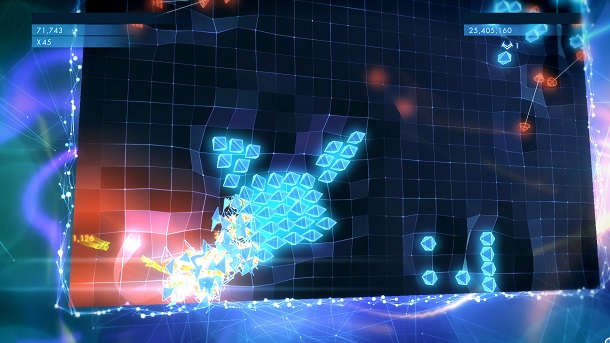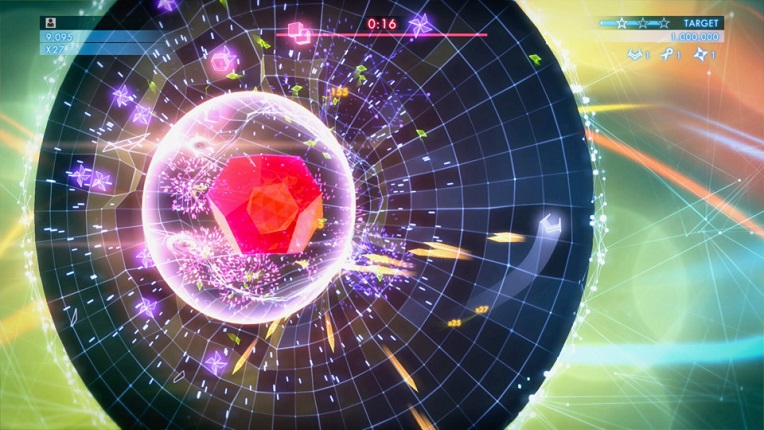Geometry Wars 3: Dimensions has some really big shoes to fill.
First introduced as an in-game extra in Project Gotham Racing 2 on the original Xbox, its simple yet refined take on the classic Asteroids-style arcade experience earned it high praise. Its ever-popular sequels managed to stand out among the sea of noise present in Xbox Live Arcade and helped legitimize the concept of downloadable games in the console space, all the while staying true to the pure arcade-style shooter experience it had been known for.
Geometry Wars 3: Dimensions goes in the opposite direction, and quickly differentiates itself from its predecessors by being the first in the series to feature a campaign mode, wildly varying playfields and customizable ship loadouts.
The main focus of Dimensions is the newly introduced Adventure mode, a 50-level campaign that rapidly ramps up in difficulty as you advance and requires you to mix up your play-styles to move on. Adventure mode can be hard. Real hard. Differing game modes and requirements are doled out on a per-level basis, meaning no one strategy can be employed to just breeze through the game.

Each level has three target scores which grant a star each. Sure, you can breeze through a level and get one or two, but the progression is gated in such a way so that in order to unlock boss encounters and move on to the next section, you’ll need to go back and grind out stars. It can be extremely frustrating being one star short of a new segment and having to go through the same levels over and over, missing the target by a minuscule amount, but the satisfaction of hitting that mark at the very last second is pretty fantastic.
Level design in Adventure mode varies on a per-level basis. In the past, all games have employed a more or less identical rectangular playfield. Dimensions turns the whole thing on its head by literally adding a new level of depth to the levels in its introduction of three-dimensional playfields of radically differing shapes and sizes.
While three-dimensional playfields are nothing new for this style of shooter (Housemarque’s Super Stardust series have been doing it for years, as have several others) the extent of the varying level designs is.
Granted, not all of them are hits, and it can be frustrating when the visible area is be really narrow and enemies can pop out from around a corner with little to no time to react, causing a near-instantaneous death and throwing off the whole rhythm of play. This is more the case on the on the more cylindrical playfields, such as the pill or peanut-shaped stages, than the spherical or cubic ones, which are thankfully few and far between

For every miss, though, there are way more hits. One level in particular features two halves of a sphere split down the center, requiring you to bounce back and forth through a central portal to take out enemies and drive up your score before time runs out.
Loadouts are another one of the major changes introduced in Dimensions. Loadouts start with the selection of a drone. The drone serves as your companion ship and perform differently depending on the model chosen, each seemingly geared geared toward different styles of play. I went with the “Collect” drone, which flies around the map collecting geoms while my focus stays on taking out enemies. Abilities and usefulness vary by the drone in question. For example, the “Ram” drone is able to seek out and crash through enemies, and the “Attack” drone more or less functions like a secondary gun, which is useful in various boss encounters.

Drones are then modified by combining them with a Super. These secondary abilities are generally offensive in nature, deploying homing missiles or black holes to clear out enemies in sticky situations.
The one downside I found with the whole loadout system is that there is no indication what other people on the leader boards used to achieve their scores, which can be frustrating when running the same levels over and over to try to beat a friend’s score.
Such changes mark a radical departure, especially in the execution, but the game does include a Classic mode, however, so long-time fans wont feel alienated and have the “pure” game of Geometry Wars, all of the same game modes and styles from Geometry Wars 2 are available right out of the gate.
Geometry Wars is a rare beast that comes with a certain pedigree. When Dimensions was announced after the shuttering of original developer Bizarre Creations and that Lucid Games would be developing it I had more than my fair share of doubts. and those doubts weren’t unfounded. Sure, it’s a radical departure from what came before, and the more progress-focused Adventure mode is a far cry from the series’ arcade-shooter roots, but it manages to hit most of the beats that made Geometry Wars: Retro Evolved 1 & 2 great. The trance-inducing and immensely satisfying high score-seeking experience is as addictive as it’s ever been, and all of the modes from Retro Evolved 2 are included, albeit with minor tweaks.
Is it as good as what came before? Not at all. But it’s kept me coming back day after day and engrossed me in ways that few other games could, and I have no issue recommending it wholeheartedly.
This review is based on a code sent to SideQuesting by the publisher.


No Comments